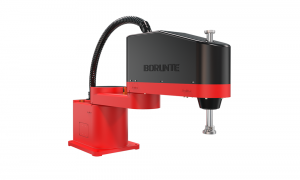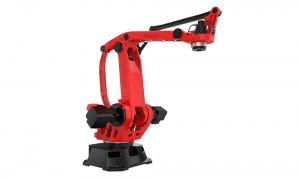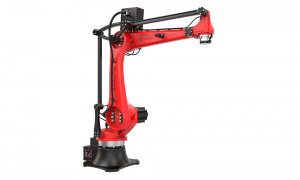
Product Introduction
BRTIRPZ2035A is a four axis robot developed by BORUNTE for certain monotonous, frequent, and repetitive long-term operations, as well as hazardous and harsh environments. It has an arm span of 2000mm and a maximum load of 35kg. With multiple degrees of flexibility, it can be used in loading and unloading, handling, unstacking, and stacking. The protection grade reaches IP40. The repeat positioning accuracy is ±0.1mm.

Accurate Positioning

Fast

Long Service Life

Low Failure Rate

Reduce Labor

Telecommunication

Basic Parameters
|
Item |
Range |
Max speed |
|
|
Arm
|
J1 |
±160° |
163°/s |
|
J2 |
-100°/+20° |
131°/s |
|
|
J3 |
-60°/+57° |
177°/s |
|
|
Wrist |
J4 |
±360° |
296°/s |
|
R34 |
68°-198° |
/ |
|

Trajectory chart


Programming and operation related issues of four axis automatic robotic arm
Q: How difficult is programming a four axis industrial robot?
A: The programming difficulty is relatively moderate. The teaching programming method can be used, where the operator manually guides the robot to complete a series of actions, and the robot records these motion trajectories and related parameters, and then repeats them. Offline programming software can also be used to program on a computer and then download the program to the robot controller. For engineers with a certain programming foundation, mastering quadcopter programming is not difficult, and there are many ready-made programming templates and function libraries available for use.
Q: How to achieve collaborative work of multiple four axis robots?
A: Multiple robots can be connected to a central control system through network communication. This central control system can coordinate the task allocation, motion sequence, and time synchronization of various robots. For example, in large-scale assembly production lines, by setting appropriate communication protocols and algorithms, different four axis robots can respectively complete the handling and assembly of different components, improving overall production efficiency and avoiding collisions and conflicts.
Q: What skills do operators need to possess to operate a four axis robot?
A: Operators need to understand the basic principles and structure of robots, and master programming methods, whether it is demonstration programming or offline programming. At the same time, it is necessary to be familiar with the safety operating procedures of robots, such as the use of emergency stop buttons and the inspection of protective devices. It also requires a certain level of troubleshooting ability, able to identify and handle common problems such as motor malfunctions, sensor abnormalities, etc.


Maintenance and upkeep related issues of four axis automatic robotic arm
Q: What are the daily maintenance contents of four axis industrial robots?
A: Daily maintenance includes checking the appearance of the robot for any damage, such as wear and tear on the connecting rods and joints. Check the operating status of the motor and reducer for any abnormal heating, noise, etc. Clean the surface and interior of the robot to prevent dust from entering electrical components and affecting performance. Check if the cables and connectors are loose, and if the sensors are working properly. Regularly lubricate the joints to ensure smooth movement.
Q: How to determine if a component of a quadcopter needs to be replaced?
A: When the components experience severe wear, such as the wear of the shaft sleeve at the joint exceeding a certain limit, resulting in a decrease in the robot's motion accuracy, they need to be replaced. If the motor frequently malfunctions and cannot function properly after maintenance, or if the reducer leaks oil or significantly reduces efficiency, it also needs to be replaced. In addition, when the measurement error of the sensor exceeds the allowable range and affects the operational accuracy of the robot, the sensor should be replaced in a timely manner.
Q: What is the maintenance cycle for a four axis robot?
A: Generally speaking, appearance inspection and simple cleaning can be conducted once a day or once a week. Detailed inspections of key components such as motors and reducers can be conducted once a month. Comprehensive maintenance, including precision calibration, component lubrication, etc., can be carried out quarterly or semi annually. But the specific maintenance cycle still needs to be adjusted according to factors such as the frequency of use and working environment of the robot. For example, robots working in harsh dust environments should have their cleaning and inspection cycles appropriately shortened.

-

Transport
-

stamping
-

Mold injection
-

stacking
Products categories
BORUNTE and BORUNTE integrators
In the BORUNTE ecosystem, BORUNTE is responsible for the R&D, production, and sales of robots and manipulators. BORUNTE integrators utilize their industry or field advantages to provide terminal application design, integration, and after-sales service for the BORUNTE products they sell. BORUNTE and BORUNTE integrators fulfill their respective responsibilities and are independent of each other, working together to promote the bright future of BORUNTE.
-
-
-

Top























